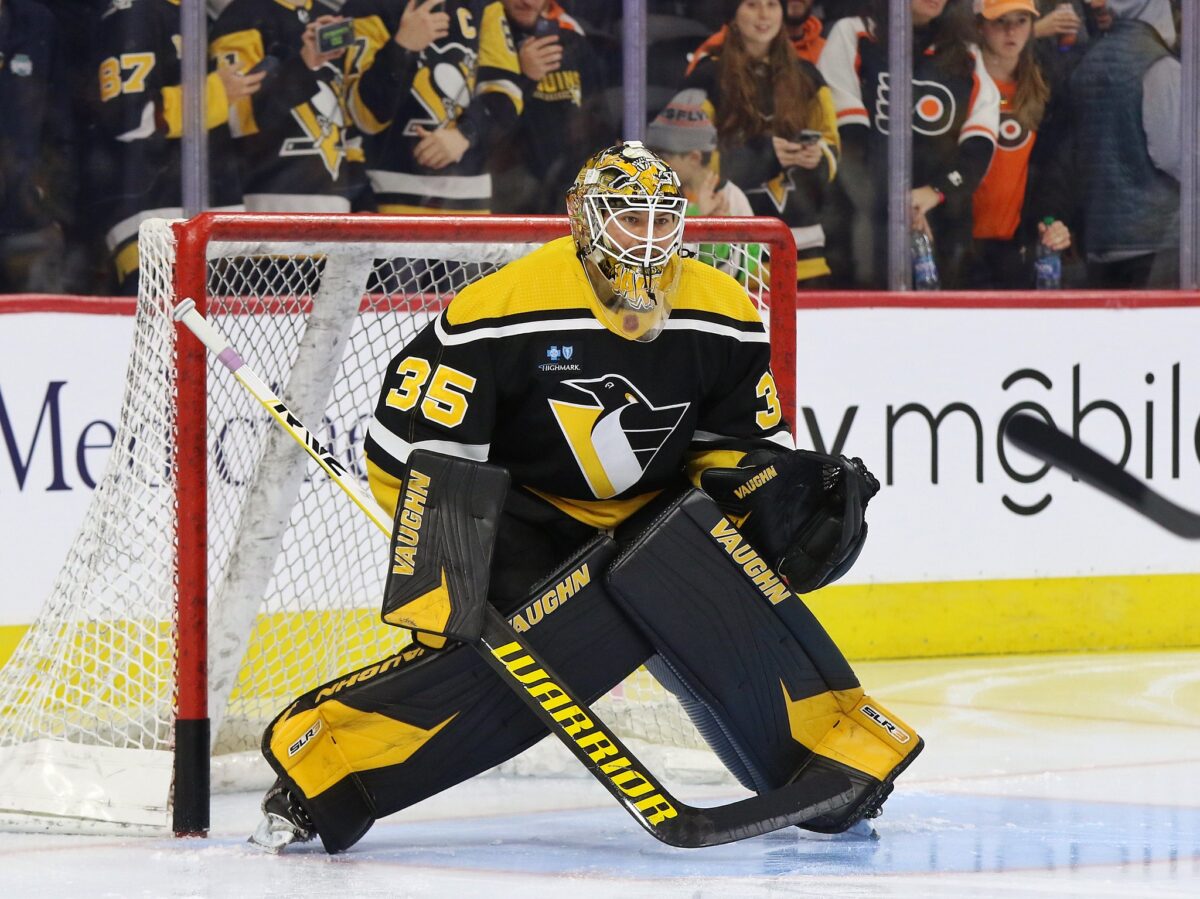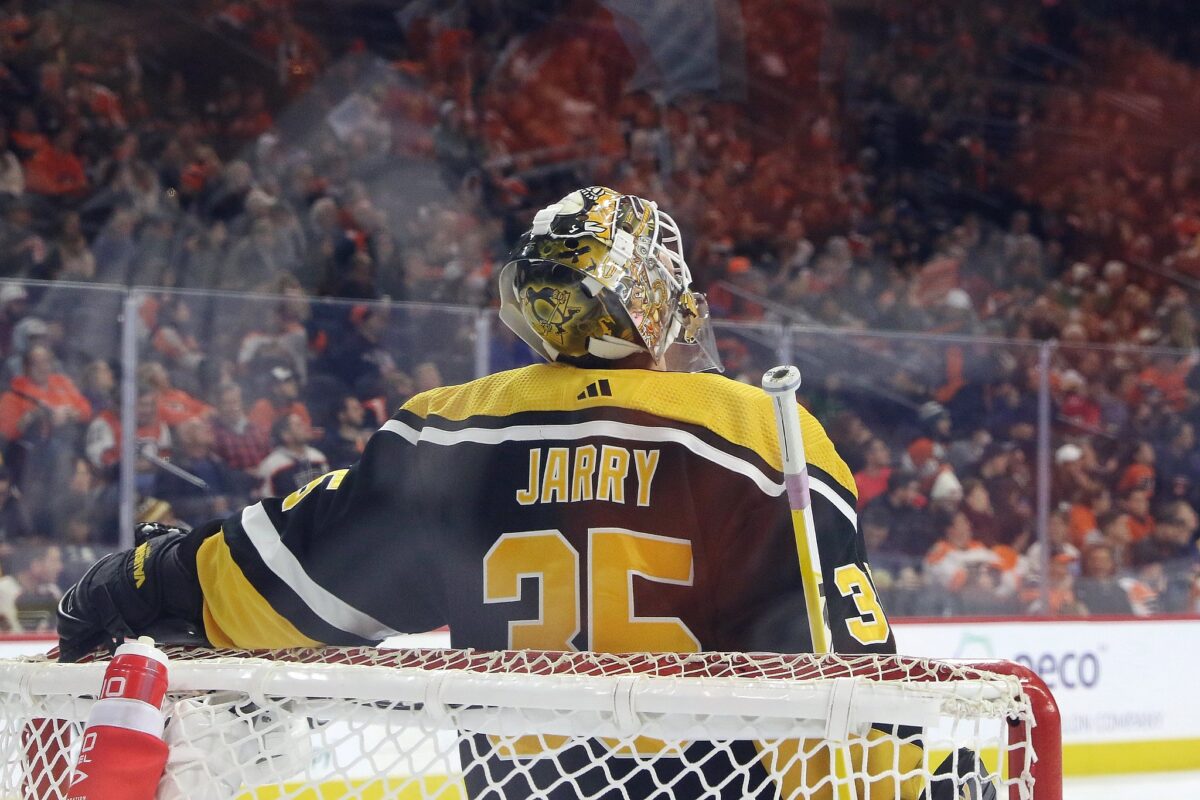Tristan Jarry’s five-year, $5.375-million-a-year extension with the Pittsburgh Penguins has been the team’s most contentious move this summer. But it was the wisest decision given the market environment, the contract structure, and comparing the options at hand. There was a lot of talk about how the deal was betting the team’s future on him. The reality is far less extreme and simply smart management of a valuable asset.

Jarry was considered the top netminder in free agency. The Penguins snagged the number one goalie on the market this year and on a deal that was the perfect middle ground for everyone involved. The move gives them roster flexibility, keeps the player happy, and keeps Pittsburgh’s options open for using him as a future commodity.
The Ideal Deal
Jarry’s contract is just long enough to provide a degree of stability for him without binding the Penguins to him into his mid-30s. A modified no-trade clause offers him some control over his future in return for that lower term. In addition, 20 clubs remain as options in the event that the team needs to trade him at some point. Had they gone lower on either term or money, they would have risked being outbid by competitors willing to give closer to the five-year, $5.3 million average annual value (AAV) range.
In the best case, this contract will see Jarry become one of the most affordable All-Star-level goalies by locking him in at a mid-range price for five years while new salaries continue to rise along with the cap. At worst, it maintains him as a valuable trade chip for the future in a league that’s always in need of competent goaltenders. The Penguins can market him as an affordable under-30 starter, who’s had some bad injury luck and just needs a change of scenery.
Competing Clubs
Jarry was undoubtedly in demand this summer with his status atop the goalie free agents list. The Ottawa Senators, Carolina Hurricanes, Vegas Golden Knights, Winnipeg Jets, Los Angeles Kings, and San Jose Sharks were all evaluating the position this offseason. The Jets are dealing with a trade request from number one goalie Connor Hellebuyck. The Anaheim Ducks might be approaching that juncture with their starter John Gibson too. There were plenty of seats available in the game of musical goalie chairs and Jarry was at the front of the line.
Change Is Costly
Jarry leaving would have been a big risk this year. The alternatives were thin and the contracts handed out weren’t significantly less expensive. There wasn’t an upgrade available in this free agent class.
Joonas Korpisalo was the highest-priced goalie who changed teams this summer when he signed with Ottawa for five years at $4 million a year. He is a year older than Jarry but comes with a terrible injury track record. He missed a remarkable 81 games over the last four seasons while playing only 94 games. Yet he signed a contract that matched Jarry’s in length and was nearly as costly.
Adin Hill, 27, obtained the second most valuable goalie contract behind Jarry when he re-signed with Vegas for two years at $4.9 million per year. Although he just won a Stanley Cup, Hill has never played as much as a fourth of an NHL season in a single year. He has also never been a solo starter. He had one run of playoff success but against the backdrop of a completely unproven regular-season career. Any team that would have bid for his services would get to pay nearly $5 million a year to test him out in this new role.
Frederik Andersen is another name that garnered interest as a starter option. He re-signed with the Hurricanes for two years at $3.5 million a year. Andersen was also the oldest of the leading goaltending choices as he’ll be 34 at the season’s start. He has a checkered injury track record and came with a more restrictive 15-team no-trade list.
Had the Penguins gone the trade route instead, they were faced with some of the most expensive goalies in the league like Hellebyuck and Gibson. Obtaining them would have required a sizable bounty that would have included a mix of first-round draft picks, their rare prized prospects, and young NHL players like P.O. Joseph or Ty Smith. It also would have prevented the team from chasing big guns like Erik Karlsson by burning their available cap space. Such a plan would have crippled the team going forward rather than empowering it.
Impression vs. Reality
Despite his reputation for injury, Jarry has not faced as spotty of a history as he’s assumed to have. He’s missed just 33 games due to ailments in the five seasons he’s been the Penguins’ starter or primary backup. He has played 156 games during that span.

The misconception is likely due to two consecutive seasons when substantial injuries occurred for him at times when the team simultaneously had major disappointments. His multiple injury runs in 2022-23 kept him out for key stretches of play in the late winter. The Penguins later failed to win the game needed to make the playoffs, shutting them out of the postseason for the first time in 16 years. The year prior in 2021-22 saw him sidelined with a foot fracture in the final stretch of the year and the first six games of a close playoff series to the New York Rangers that was ultimately lost by a single overtime goal. These recent memories have led to the overblown idea that the seven-season veteran and two-time All-Star is flakey and brittle.
The failures laid at Jarry’s feet have been those of prior Penguins general managers Jim Rutherford and Ron Hextall. Both men ignored addressing the team’s need for net reinforcements. They continued to guarantee defeat by refusing to add a more reliable backup to support Jarry for the last four seasons while his workload appeared to be a factor in his injury issues. He’d be sidelined most frequently after the holiday break and his most impressive performance streaks and All-Star game nominations came from first-half play.
A New Netminding Era
That past-due bill was finally paid by new President of Hockey Operations Kyle Dubas during free agency. He was savvy enough to add significant insurance behind Jarry in addition to hammering out that extension. The team signed Alex Nedeljkovic and made a third netminding addition in Magnus Hellberg while retaining Casey Desmith. This gives them a four-man deep goalie roster.

Net strength will be one of their highlights going forward in a way the team hasn’t seen since 2017-18. That year they ended up relying on a goalie-by-committee scheme featuring Matt Murray, Jarry, DeSmith, and Antti Niemi. It helped propel the team to the second round of the playoffs. The Penguins now have the top free-agent goalie under contract, flexibility with what they can do with him in the future built into that deal, and a baseball-like bullpen of additional goaltenders to mix and match until they find the mix that best positions them to win.
These offseason moves were some of the most inventive and strategically sound goaltending revamp plans in the NHL’s recent history. They addressed the team’s needs in a variety of ways that gives them the most flexibility in the net going forward. There’s no longer a single point of failure for the Penguins between the pipes, which is something that could radically change their performance in the upcoming season.